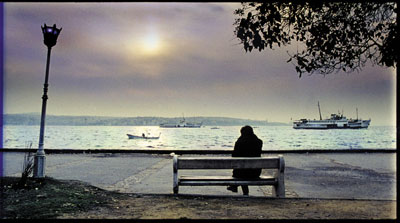
If there's ever a Greek director worth looking into, it's Theo Angelopoulos. Upon my first viewing of his 1988 film Landscape in the Mist, I was thoroughly mesmerized. It's a shame that he seems under-seen and under-appreciated, outside of some dedicated niches of film critics. Perhaps Ulysses Gaze is his most well-known piece, but there's no denying that Landscape in the Mist is a shattering masterpiece. Michalis Zeke and Tania Palaiologou, who carry the film with leaps and bounds, portray two young children traversing a war-torn Greek landscape in search of an indistinct father figure. Their main goal, which as the film progresses becomes shrouded in (as the title suggests) mist, is to find the father whom their mother told them about but they've never seen. When they do escape from their home by catching a train early on in the film, they inevitably begin a downward slope towards disillusionment.
What keeps them going is faith, although it is not clear in the viewer's mind what they're really searching for, and judging by Voula's (Palaiologou's character) requests to the people who drive her and her young brother Alexandros, "far away" means they don't know either. A lack of a proper parental figure for these two children results in the heavy handedness of life that they are propelled into. Hitchhiking on the side of a soaked and windy highway, it is evident that these two vagabonds have been forced into adulthood far too quickly. Like the donkey in Bresson's Au Hasard Balthazar, Voula and Alexandros are witness to the cruelties of man. In two of the most harrowing scenes of the film, the two must encounter a horse being dragged across the snowy ground of a market square and a greedy malicious truck driver. There is no doubt in my mind that Palaiologou and Zeke handled these performances with incredible professionalism, something that's unheard of at their ages.
The film holds certain parallels to a Fellini film, specifically La Strada, in its continuous use of travel and underbelly accordion and violin performers amidst chaotic times. However, it's stylization is not far off from a Tarkovsky or Tarr film. Georgia Brown of The Village Voice noted that the film had "some of the most exquisite compositions you'll ever see..." - I wouldn't disagree. The imagery ranges from majestically beautiful to powerfully absurd, and the long, expertly choreographed takes are breathtaking. You can never tear your eyes away from the magic that is on the screen. An intriguing aspect of this film is its frequent exposes of heartbreak or turmoil and casual or celebratory moments. During the two scenes I already cited as being heartbreaking, the camera slowly moves upward to reveal events in the near background that seem oblivious to the terrors of the story. As Angelopoulos sees it, this is the inevitable sadness of life. People will play out their own hopes and dreams at the expense or disinterest of others. In Voula and Alexandros' case, they may still being playing out their hopes and dreams, even if the ending of the film perhaps suggests otherwise. With this, Angelopoulos shows he is interested in what is not seen on screen, or what's in the mist. Landscape in the Mist is a staggering work of art.






